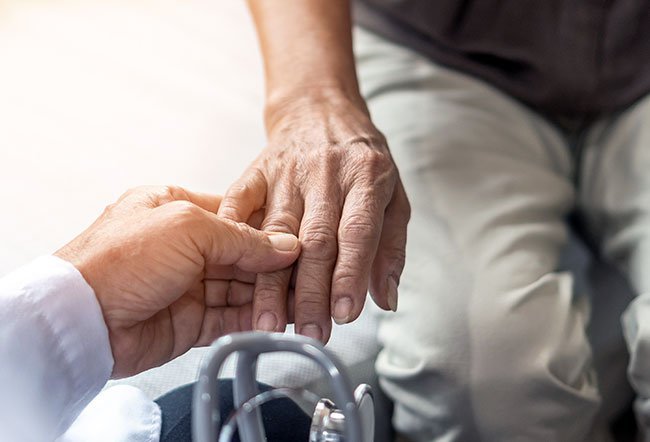Early Signs of Arthritis in the Fingers
Types of arthritis

The joints in the hands and fingers are very delicate. There are over 100 different types of arthritis. The three main types are osteoarthritis, rheumatoid arthritis and psoriatic arthritis. The small joints of the hands and fingers are usually affected by rheumatoid arthritis. The earliest signs of arthritis are pain, swelling and stiffness. If these symptoms are experienced in the fingers, it is likely because of rheumatoid arthritis, and this requires medical attention.
- Rheumatoid arthritis (RA) is a chronic inflammatory autoimmune disorder that typically affects the small joints (large joints may also be affected) and other body systems, such as the skin, eyes, lungs, heart and blood vessels. An autoimmune disorder is a condition where a person’s immune system attacks their own body tissues.
- Osteoarthritis (OA) occurs due to wear and tear on the joints. In OA, the weight-bearing joints like the knees, hips and ankles are more commonly affected. Unlike OA, RA affects the lining of the joints, leading to inflammation, pain and swelling that eventually leads to bone erosion and joint deformities.
- Psoriatic arthritis can also affect the digits, causing sausage-like swelling of the fingers due to inflammation of tendons and ligaments attached to the joint.
What are the signs and symptoms of arthritis in the fingers?
The joints of the hands and fingers are more commonly affected in rheumatoid arthritis compared to other types of arthritis. Some of the earliest signs of arthritis are pain, swelling and stiffness. If these symptoms are experienced in the fingers, it is likely because of rheumatoid arthritis. The signs and symptoms of arthritis in the fingers include
- Pain: Pain in the affected joints is the earliest sign of any type of arthritis. The pain may be episodic and it may increase after excessive activity. Pain in the early stages of arthritis may come and go. The pain may also worsen and be severe after waking up in the morning.
- Swelling: The joint may become inflamed and swollen because of stress and joint damage.
- Stiffness: Arthritis causes joint swelling and as a result, there is stiffness that decreases the range of motion of the joint. Joint stiffness usually occurs in the morning after waking up and decreases throughout the day with activity.
- Popping sounds: There may be popping sounds when the joint is flexed. This may also indicate the beginning of arthritis.
- Joint deformity: The cartilage in the joints may erode in patches. There is also a weakening of the muscles and ligaments in the joint. This results in crooked fingers.
- Warmth: Inflammation of the joint leads to warmth and redness of the affected joints.
- Mucus cysts: These are small, fluid-filled sacs (cysts) that appear like small dents or ridges on the fingers commonly occurring at the end of the finger and under the fingernail.
- Bone spurs: As joint damage worsens, extra bone may form in the joints called bone spurs. They appear as knobby growths and give the fingers a gnarled appearance. Bone affects joint function as well.
What causes rheumatoid arthritis?
Rheumatoid arthritis is an autoimmune disorder (when the body’s immune system mistakenly attacks its own body tissues). Certain factors increase the risk of RA. The common risk factors are
- Sex: Women are at a higher risk than men.
- Age: RA most commonly begins in middle age.
- Family history: A positive family history increases the risk of the disease.
- Toxin exposure: Smoking and other environmental exposures to asbestos or silica increase RA risk.
- Obesity: Obese women under the age of 55 are at increased risk.
How is rheumatoid arthritis treated?
There is no cure for rheumatoid arthritis. It is a lifelong disease with multiple flare-ups and periods of remission (asymptomatic periods). There are various treatment options available to control the progression of the disease and prevent complications. Treatment may usually involve a combination of more than one treatment modality. The treatment options are
- Medications
- NSAIDs: Nonsteroidal anti-inflammatory drugs (NSAIDs) can relieve pain and reduce inflammation.
- Steroids: Corticosteroid medications suppress the immune system. They reduce inflammation and pain and delay joint damage.
- Disease-modifying antirheumatic drugs (DMARDs): These drugs are effective in the treatment of RA. They suppress inflammation and relieve symptoms. They can slow the progression, prevent joint deformities and decrease the risk of systemic complications. Some commonly prescribed DMARDs are methotrexate, hydroxychloroquine, sulfasalazine and leflunomide (Arava).
- Biological modifiers: These are a newer generation of DMARDs and they are usually taken with DMARDs. They suppress inflammation. Some commonly used biological agents are infliximab, rituximab, sarilumab, etc.
- Physical therapy
- Patients are usually referred for physical or occupational therapy to learn exercises to improve and maintain joint flexibility and to rehabilitate joints.
- Surgery
- Surgical procedures like joint replacement may be performed to help restore joint function and anatomy as well as reduce pain.
